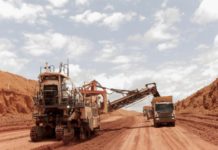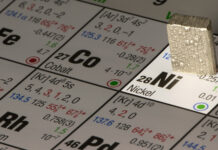
[miningmx.com] — BRINGING in Japan’s JOGMEC to fund three-years of exploration on a Botswana nickel project has freed up Discovery Metals to give undivided attention to developing a $150m copper and silver mine in Botswana.
Japan Oil Gas and Metals National Corporation (JOGMEC) will spend A$3m to earn into a 60% stake in the Dikoloti nickel exploration venture AIM- and ASX-traded Discovery has in northeastern Botswana. If anything of substance is found, JOGMEC is likely to pass it over to a Japanese partner. If it turns out to be a winner, Discovery has the option of continuing to participate, or diluting down to just a royalty.
If the deposit is not big enough to excite the interests of a Japanese major, Discovery could take a lead role in developing a smaller project.
Dikoloti had more or less dropped off Discovery’s must-do list as the company turned its full attention on the Boseto Copper project in the south west, where initial plans are for a 25,000 tonnes of copper-in-concentrate and 700,000 oz of silver a year mine, said managing director Brad Sampson.
The scale of the two ventures offers a clue when Discovery doesn’t mind becoming the minority partner in Dikoloti., where there is a JORC-compliant inferred resource of 28,700 tonnes of nickel at a cut off grade of 0.5% nickel.
Boseto, by contrast, has indicated resources of 4.7 million tonnes at 1.6% copper and 24 grams/tonne (g/t) of silver and inferred resources of 45 million tonnes at 1.4% copper and 17.2 g/t silver, giving a total of 753,000 tonnes of copper and 29 million oz of silver at a 0.6% copper cut-off grade.
“At Boseto we’re in good shape and we’ve not felt the need to find a joint venture partner,’ Sampson told Miningmx.
A bankable feasibility study will be completed in the first quarter of 2010, with offtake agreements, environmental permitting and project finance around that time too. Construction could start by the middle of that year, with an 18-month build programme to deliver the first concentrate by the end of 2011.
The capital cost has been ramped up by $20m to $150m, building it contingency capital. “It’s an interim number. We won’t get better capital cost information until February next year. Queries have gone out to vendors of major capital items now,’ Sampson said.
The thinking on the funding is half equity, half debt. “We don’t have an offtake deal with anybody yet and we’d expect the offtaker to contribute something on the equity side, some skin in the game there,’ he said. The top 20 shareholders own around 80% of the company and they are generally large institutions.
On the debt front, Sampson said: “We think the real cost of debt is starting become more reasonable again.’
The Boseto project will have costs in the middle of the global cost profile at $1.04 per pound over a 10-year life, Sampson said. “We’ll never be in the lowest quartile because our mineralisation is copper and silver. We don’t have gold, cobalt or molybdenum, any of those things that can give you the nice juicy by-product credits to push us into the lowest-cost quartile.’
The Boseto project is in a geological structure called the Kalahari Copperbelt, which has been explored over the past 40 years by companies like Anglo American, US Steel, Delta Gold and Genmin. Sampson said the reason why a company like Anglo hadn’t opted to build a mine on the belt was because of a lack of infrastructure and surface water, which was now in place, and low copper prices, weighed up against projects in other well-known and better serviced copper destinations.
“The nature of our mineralisation and geometry means the majors would have found it hard to see the scale of project they were after,’ he said. Zambia had higher grades and better infrastructure at the time.
On the Namibian side of the border, a number of opencast and underground mines have been built on the belt.
One of the drawbacks of mining in Botswana is the depth of sand over ore bodies, something diamond companies grapple with. Sampson said on some of Discovery’s ore bodies the average sand depth was five metres, with the rock outcropping in certain places.
When the sand becomes a lot deeper, the economics of the project change for the worse. The sand cover becomes thicker further south, which means opencast mining becomes less likely and underground mining is the preferred option. Discovery is investigating underground potential for the project, and scoping level work will be completed as part of the bankable feasibility study.
The concentrate will be trucked into Namibia and then either put on a train or further trucked to Walvis Bay. Asked about the Tsumeb smelter, Sampson said the plant was treating high-arsenic-content concentrate, charging a higher fee, making it an unlikely destination for Discovery’s concentrate.










